The Poetic Edda: A Study Guide
The Speech of the Masked One
[PREVIOUS][GRIMNISMAL 31][NEXT]
[MAIN][HOME]
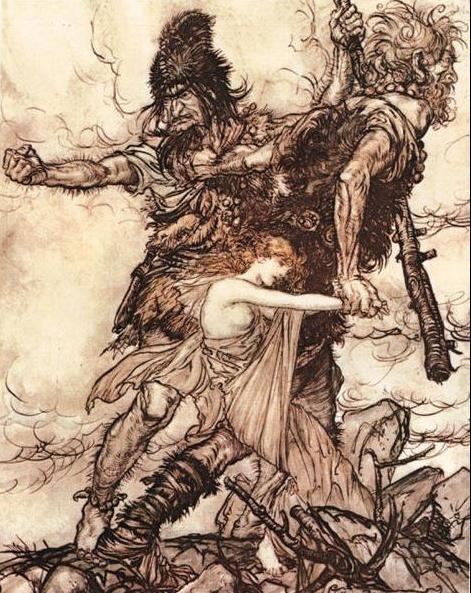
The Giants sieze Freya by Arthur Rackham 1917
II. “...under the second Hrímþursar (frost-ogres)”
The poem
Hrafnagaldur Óðins, provides us with definite information about
the kind of creatures that live beneath the northern root of Yggdrasil’s Ash:
|
Jörmungrundar |
25. At Jörmungrund's |
Thus there can be little doubt that in the original
heathen conception, the northern root of Yggdrasil, extending to Niflheim and
Hvergelmir (cp. Gylfaginning 4), is the root which Grímnismál 31 says extends to
the Hrímþursar, “frost-ogres.”
Grímnismál 34 places a host of noxious creatures there, naming both serpents and
the sons of a wolf, Grafvitnir, saying: “More serpents lie under Yggdrasil’s
ash than any dumb ape can believe,” (Ormar fleiri liggja und aski
Yggdrasils, en þat of hyggi hverr ósviðra apa).
In Grímnismál 35, the dragon Niddhögg is said to gnaw the tree from below. He is
mentioned again in Völuspá. Describing the scene “to the north on Niði’s plains”
(Stóð fyr norðan, á Niðavöllum), Völuspá R35-R38 speaks of a hall
standing “far from the sun” on the Corpse-beaches (Náströndu). Compare
Völuspá 5: Sól varp sunnan, ‘the sun from the south.” "Far from the
sun" the dragon
Niddhögg makes his home.
Völuspá R38/H35:
|
Sá hon þar vaða |
There she
saw wade heavy streams perjurers and murderers and those who seduce another’s confidant. There Niddhögg sucks Náir (corpses) gone forth, A wolf tore men Understand ye yet or what? |
Although Snorri uses the words jötun and hrimþurs, (giant and frost-ogre), interchangeably, there seems to be some sort of a distinction made between them in the Poetic Edda. Giants hostile to the gods are frequently characterized as þursar. Thor, in particular, is the slayer of þursar. In Hymiskviða 19, he is designated as þurs ráþ báni, “the planner of þurs’ death.” In Skírnismál 34, Frey’s messenger bids both jötnar (giants) and hrímþursar (frost-ogres) to bear witness to a curse, indicating they are not one and the same. What the distinction is, however, is not clear.
The Cleasby/Vigfusson Dictionary defines the word þurs this way:
“ÞURS (sounded þuss), m., this interesting word occurs in no other Teutonic language; [Dan. tosse = a fool]:-- a giant, with a notion of surliness and stupidity”
The Eddic poem Skírnismál provides us with further insights into their character.
When the giantess Gerd rejects Frey’s marriage proposal, his messenger Skirnir curses her in Skírnismál 27-36. First he threatens to send her where the sons of men will no longer see her again; by which he no doubt means the kingdom of death (þar skaltu ganga, er þik gumna synir síðan æva séi.) he shall dispatch her with a sword, which he refers to as a “taming-wand.” There, Skirnir says, fiends (tramar) will bow her neck, and wretches shall serve her goat urine “at the tree’s roots,” (þar þér vilmegir á viðar rótum geita hland gefi). Thus he curses her to a dismal existence near one of Yggdrasil’s roots.
|
"Sér þú þenna mæki, mær, |
25. See this sword,
maiden! thin, sign-marked, which I have in hand here? Beneath this edge —the old Jötun shall fall— is your father’s fate. |
|
Tamsvendi ek þik drep, |
26. With
taming-wand (the sword) I will strike you, and I will tame you, maiden, to my will. You shall go where sons of men never see you again. |
|
Ara þúfu á |
27. On an eagle’s
mount you shall early sit, looking out of the world longing for Hel. Food shall be more loathsome to you than to anyone among men is the shining serpent. |
|
At undrsjónum þú verðir, |
28. A spectacle
you shall be, when you go forth; Hrimnir shall glare at you, Every creature shall stare at you; You shall be more widely known than the watchman of the gods, as you gape through the gate. |
|
Tópi ok ópi, |
29. Frenzy and
wailing, pangs and unbearable need— May your tears grow with grief. Sit down, and I will tell you of a heavy sea of sorrow, and a double grief. |
|
Tramar gneypa |
30. Fiends shall
bow your neck the entire day, in the Jötuns’ courts. To the Hrimthursar’s halls, You shall each day crawl without choice, crawl, without joy For pleasure you shall weep and grief accompany your tears. |
|
Með þursi þríhöfðuðum |
31. With a
three-headed Thurs You shall ever dwell, or be husbandless… |
Gerd shall spend bitter days in giant’s courts (jötna görðum), and when she ventures outside, Hrimnir (a name formed from hrím, ‘frost’) and other creatures shall stare at her coldly. To them, she will be more infamous, than Heimdall, the watchman of the gods, who prevents their number from crossing Bifröst (Gylfaginning 27: Hann er vörðr goða ok sitr þar við himins enda at gæta brúarinnar fyrir bergrisum). Every day, with no other choice, Skirnir says, Gerd will be compelled to crawl past him and his ilk to the “hall of the frost-ogres,” (til hrímþursa hallar).
Since Skirnir meets Gerd at her home in Jötunheim, the place he threatens to send her with his blade, a world inhabited by fiends and frost-ogres, cannot be Jötunheim, the land of the living giants. It must be the place reserved for them after death. As confirmation of this, Skirnir declares that “the þurs Hrimgrimnir shall have you down below the Corpse-gates,” (Hrímgrímnir heitir þurs er þik hafa skal fyr nágrindr neðan).
But the passage makes clear that this place is not Hel. Skirnir says that once removed here, Gerd shall sit on a hillock and gaze out of that world, through the gates, longing for Hel (27: Ara þúfu á skaltu ár sitja horfa heimi ór, snugga heljar til; 28: gapi þú grindum frá). In comparison to the fate Skirnir threatens her with, she will long to be in Hel. This place is not Hel, although it is lies just beyond the gates of Hel. This place can only be Niflhel. As we saw in Grímnismál 29, one of Bifröst’s bridgeheads falls to the north, in Niflhel. This is the side that Heimdall watches. For this vigilance, the giants there loathe Heimdall, the watchman of the gods, almost as much as they will loathe Gerd.
The Poetic Edda consistently differentiates between Hel and Niflhel. Niflhel is portrayed as a place of punishment. In Vafþrúðnismál 43, men are said “to die out of Hel and into Niflhel,” (níu kom ek heima fyr Niflhel neðan; hinig deyja ór helju halir." In Gylfaginning 3, Snorri clarifies on this, saying that wicked men first come to Hel and then proceed to Niflhel (en vándir menn fara til Heljar ok þaðan í Niflhel. Þat er niðr í inn níunda heim). The passage from Hel to Niflhel is thus as final as the one from Midgard to Hel. Both are designated as deaths.
Therefore Skirnir must curse Gerd to a life in Niflhel, the realm which Hrafnagaldur Óðinns locates in the north, and populates with þursar and náir. Skírnismál confirms that Yggdrasill’s roots extend here (á viðar rótum).
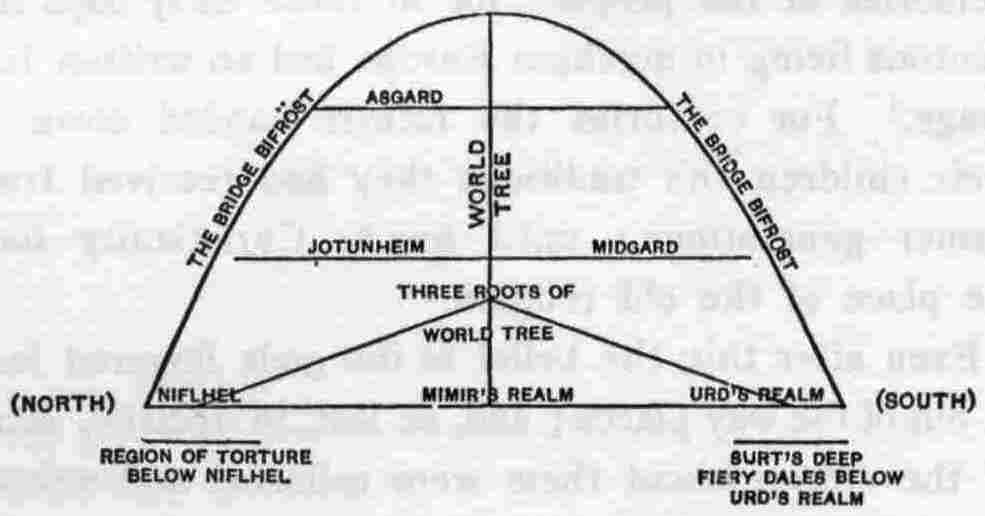
NIFLHEL HEL
Illustration of Yggdrasil's Ash from
The Nine Worlds by Mary Elizabeth Litchfield, 1899
Giants in the Earth
Snorri informs us that the venomous streams of Hvergelmir flow out of Niflheim (Gylfaginning 5).
| Ok þá er sá íss gaf staðar ok rann eigi, þá hélði yfir þannig, en úr þat, er af stóð eitrinu, fraus at hrími, ok jók hrímit hvert yfir annat allt í Ginnungagap." | “…the
drizzling rain that rose from the venom congealed to rime, and
the rime increased, frost over frost, each over the other, even
into Ginnungagap." |
| Ok þá er mættist hrímin ok blær hitans, svá at bráðnaði ok draup, ok af þeim kvikudropum kviknaði með krafti þess, er til sendi hitann, ok varð manns líkandi, ok var sá nefndr Ymir, en hrímþursar kalla hann Aurgelmi, ok eru þaðan komnar ættir hrímþursa, | “And when the breath of heat met the rime, so that it melted and dripped, life was quickened from the yeast-drops, by the power of that which sent the heat, and became a man's form. And that man is named Ymir, but the hrím-þursar call him Aurgelmir; and thence come the races of the frost-ogres.” |
Ymir, the progenitor of the giants, is made from the very substance that flows out of Hvergelmir. Thus the root found in the north there is the one that Grímnismál 31 says extends to the frost-ogres (annarri hrímþursar). Thus Niflheim is identical to Niflhel. Niflheim is the primeval world to the north. Niflhel is it’s counterpart after the upper worlds have been created from Ymir’s corpse.
Still more concerning this the nature of þursar can be gleaned from Skírnismál.
Skirnir threatens Gerd with celibacy in her new home. Despite this, she will be wedded. In Skírnismál 31, he says that she shall have a three-headed þurs as her husband. He further curses her by cutting the rune Þurs and three more characters which will inflict her with ‘frenzy’, ‘pangs of desire’ and ‘unbearable need’. The implication is clear:
If she refuses to marry Frey, she will be paired with a multi-headed þurs incapable of satisfying the burning desire inflicted upon her. The giant’s name is Hrim-grimnir, ‘Frost-Grimnir’. Since Grimnir is a name of Odin, the father of the gods, the name of her fated husband, Hrímgrimnir (‘Frost-Grimnir’) appears to be a poetic designation for the ‘Odin of the frost-ogres’, the father of the hrímþurs race.
Unlike jötuns, such as Gerd, who marry into the Aesir and Vanir clans, Alvismál 2 confirms that þursar are not born to have brides (Þursa líki þykki mér á þér vera; ert-at-tu til brúðar borinn); In other words, like Ymir himself, they reproduce asexually. We can also infer this from their origin.
The mythology knows two types of giants, those born from under Ymir’s arm and those born from Ymir’s feet. Vafþrúðnismál 32-33 inform us:
|
|
Odin: 32. Tell me seventhly, since you are called wise, and if you know, Vafthrudnir! how he begot children, the bold Jötun, since he had no giantess’ pleasure? |
|
|
Vafthrudnir: 33. Under the arm, it’s said, of the Hrimthurs, grew a maid and man together; foot with foot begot, of that wise jötun's six-headed son. |
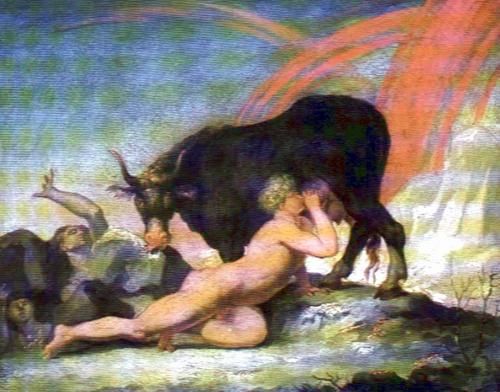 |
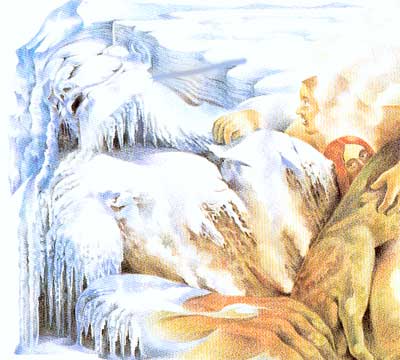 |
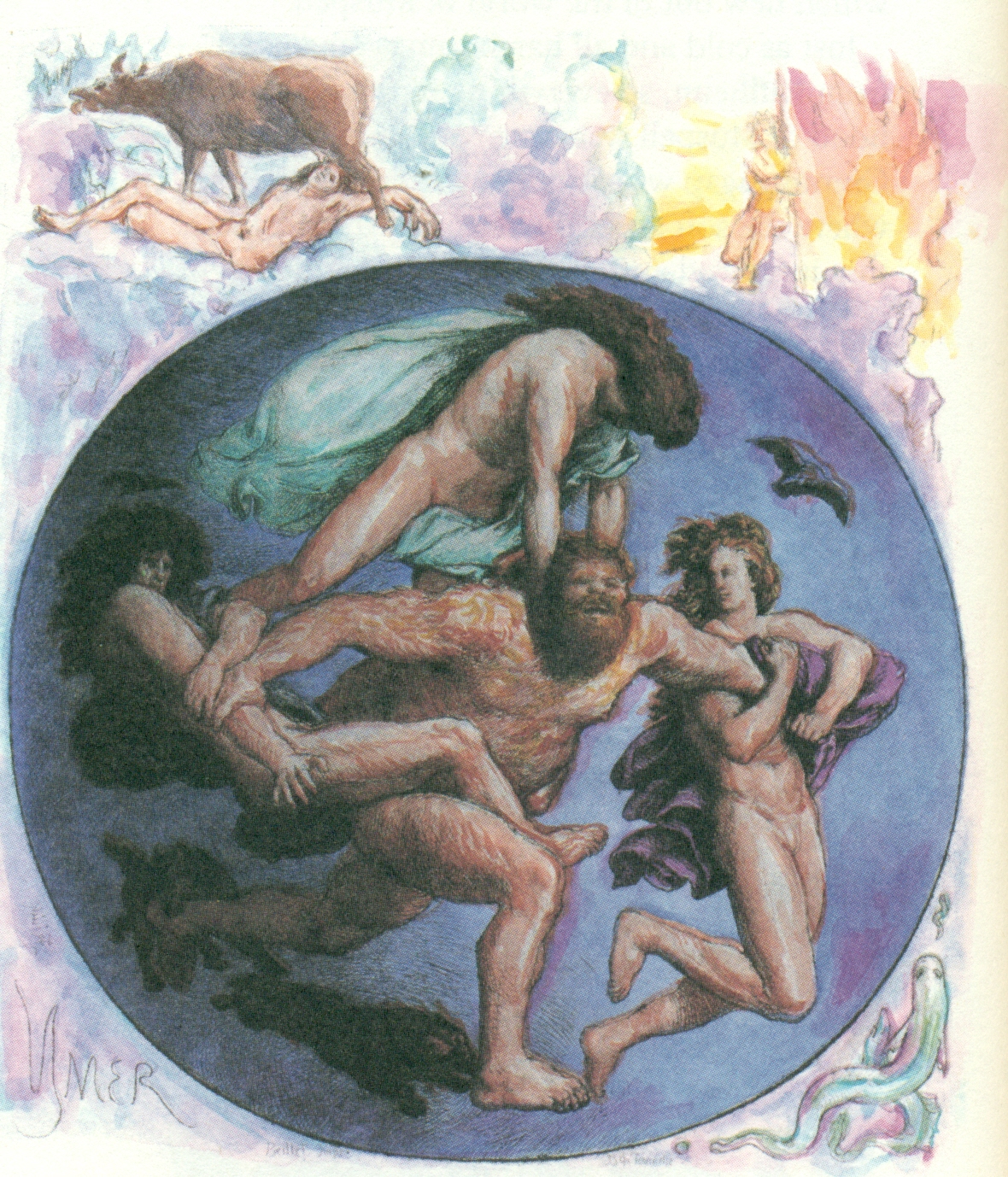 |
From under Ymir’s arm sprang up a girl and boy together indicating a sexual pair, but together, Ymir’s feet begot a six-headed son. As seen above, Hrimgrimir, the progenitor of the frost-ogres, is said to have three heads. Multiple heads seem to be a distinguishing characteristic for þursar. When Thor departs Hymir’s with the giant-kettle on his head, he is pursued by a “multi-headed” army, which may be a double entendre if the pursuing host also consisted of multi-headed giants. This is all the more likely since Hymir’s mother is said to have 900 heads (Hymiskviða 7).
While these two kinds of giants appear to have separate origins, they are all one race. Vafþruðnismál makes no distinction between þursar and jötuns, calling Ymir both a hrímþurs and a jötun in verse 33 ; in Thrymskviða, while Thyrm is characterized twice as drottin þursar, "the lord of thurses," his clan is called jötna ætt, the race of giants. Thus, the line between them, if there is one at all, is unclear. Jötun appears to be a generic deisgnation for all giants, while giants who are primarily hostile to the gods appear to be designated as þursar.
While jötuns clearly dwell in Jötunheim, a mountainous country across the sea, east of Midgard, the home of the frost-ogres (hrímþursar) is undoubtedly the frozen wasteland of Niflheim to the north. As shown above, Snorri places Hvergelmir there. That this can also be designated Jötunheim is attested to by the plural formation Jötunheimar. Since Mimir and Urd are Jötuns as well, their homes in the underworld can also be characterized as such. In the late Fornaldarsögur the land of the benevolent giant Gudmund, corresponding to Mimir, borders on that of his brother, the malignant giant Geirröd. Thus the entire lower world (called Jörmungrund in Grímnismál 20) can be designated as Jötunheim.
In Gylfaginning 4, the Elivagor (‘Icy-waves) rivers, originating in Hvergelmir, flow out of Niflheim into Ginnungagap. When these solid ice floes meet the heat coming from the south, poison-drops drip from the rime, forming the first frost-ogre, Ymir. Thus hrímþursar are closely akin to their source. The names of the first generations of frost-ogres affirm this. All of their names are formed on the pattern of Hvergelmir, the well that feeds the northern root of Yggdrasil. They are Aurgelmir, Thrudgelmir, and Bergelmir, names found in Vafþrúðnismál. In Gylfaginning, Snorri informs us that Aurgelmir is the name the jötuns called Ymir. Thrudgelmir was his son, begot by Ymir’s feet rubbing together. From this we can infer that Thrudgelmir is considered the progenitor of the thursar. Vafþrúðnismál 33 tells us that he has six heads.
In the Rigveda, beings formed from different parts of the primeval giant Purusha's body, form different social strata. Those from higher parts of his body, form the more noble castes. The same appears to be true of Ymir’s offspring.
|
Rig Veda X. 90: Purusha (man) and the Primordial Sacrifice A Thousand heads hath Purusha, a thousand eyes, a
thousand feet. On every side pervading earth he fills a
space ten fingers wide.
|
||
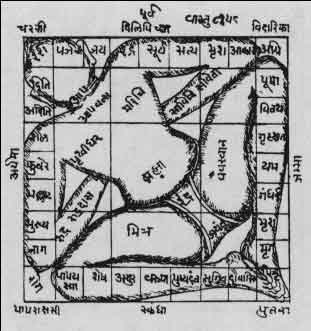 |
||
|
From that great general sacrifice Ricas and Sama-hymns
were born: Therefrom were spells and charms produced; the
Yajus had its birth from it. [Ralph T.H. Griffith, The Hymns of the Rig Veda, 1896.] |
The man and the maid born under Ymir’s arm, appear to have formed a race of giants, friendly to the gods. As members of the second generation of beings, older than Odin and his brothers, this man and maid must have held a prominent position in the mythic cosmogony. Snorri informs us that the god Borr, the son of the man licked out of the rime by the cow Audhumbla, married a giant maid named Bestla.
A strophe by Einar Skalaglamm (Skáldskaparmál 9; cp. Gylfaginning 6) confirms that Bestla (variations: Beistla, Besla, Bezla) is Odin's mother. In Völuspá, Odin and his brothers are called the sons of Borr. Together, Borr and Bestla begot the third generation of beings from creation: Odin, Lodur and Hoenir (also called Vidrir, Vili and Ve, see Lokasenna 24),
As a member of the second generation, Bestla is either identical to the maid born under Ymir’s arm, or a contemporary of hers. In addition, Hávamál 140 tells us that Bestla has a brother. Thus, Bestla and her brother are most likely the man and maid born under Ymir’s arm.
|
Fimbulljóð níu |
140. Nine fimbul-songs I learned from the famous son of Bölthorn, Bestla’s father, and a draught obtained of the precious mead, drawn from Odhrærir. |
Odin obtained nine magic-songs and received a drink of Óðrerir from Bestla’s brother, the famous son of the giant Bölthorn. The name Bölthorn is otherwise unknown. As a member of the third generation of beings, Odin’s parents would be of the second generation, and so his grandfather, Bölthorn, would be of the first.
The first creatures were the frost-ogre Ymir and the cow Auðumbla. Thus, Bölthorn is most likely another name for Ymir. That he is known by other names should come as no surprise, since Snorri informs us that the giants call him Aurgelmir, a name found in Vafþrúðnismál 30.
Since Odin obtained a drink from Mimir’s well, Bestla’s brother must be Mimir, Ymir’s famous son. As Mimir's chief disciple, Odin, the clan-chieftain of the gods, is accordingly his sister's son. Herein we have the reason for the faithful friendship which he and Mimir enjoy. Mimir is Odin’s maternal uncle, a relationship held sacred among the Germanic tribes according to Tacitus in Germania 9. According to an Icelandic proverb: "Men most turn out like their maternal uncles" (John Lindow, Handbook of Norse Mythology, p. 82). Odin and Mimir provide the divine example.
The man and maid born together under Ymir’s arm thus are best understood as Mimir and Bestla. The six-headed giant Thrudgelmir is the product of Ymir’s feet. Naturally, the giants born under Ymir’s arm are of a higher caliber than those born from his feet, just as the castes produced from the arms of the Hindu primeval giant Purusha are higher than those produced from his feet. The myth has ancient Indo-European roots.
Mimir and his closest kin are the friends and allies of the gods. As we have seen, Mimir is known in the Rigveda and the Avesta as Jama and Yima respectively (see “III. mennskir menn”). He keeps the treasures of the gods (See Grímnismál 27). Odin sacrifices an eye to him for a single draught from his well. In Sonatorrek 23, Odin is designated as Mims vinr, ‘Mimir’s friend.’ In Völuspá 46 and Sigrdrifumál 14,Odin consults with Mimir’s head (mælir Óðinn við Míms höfuð; þá mælti Mímis höfuð) and Mimir speaks true staves (ok sagði sanna stafi). In Hávamál 143, Odin distributes runes to the Æsir, while Ásviðr disseminates them to the giants. The name Ásviðr appears to be a variation of Ásvinr, the “friend of the Æsir,” thus probably indicating Mimir himself.
Mimir's home is below the central root of the world-tree, “where Ginnungagap once was” (Gylfaginning 15). It is a warm, temperate place, “as mild as a windless sky” (Gylfaginning 5), creating the ideal conditions for life. It is the same place where Mimir’s father Ymir was sacrificed, and where the upper worlds were created from Ymir’s flesh (Ymis holldi, Grímnismál 40). The sea is called blood of Ymir’s neck-wound in Sonatorrek 3, indicating that the sons of Borr drained the blood from Ymir’s neck, as one would a sacrificial victim. Like Ymir who was decapitated and dismembered (his head formed the sky, his blood the sea, his flesh the soil, etc), Mimir is also decapitated. The seeds of new life, necessary to repopulate the new world which shall rise after Ragnarök, are hidden in Hoard-Mimir grove (Hoddmimis holt) also called Mimis holldi, “Mimir’s flesh” in the Uppsala manuscript of Snorri’s Edda.
Based on its central location, and the repetitive acts of creation that take place there, Mimir’s grove is apparently the archetypal sacred grove, where sacrifices are held, to re-enact the first sacrifice, and thereby re-create the world anew. Mimir’s well thus represents the hlaut-bowl used to catch the blood of the sacrifice; and Mimir’s head in the well represents the head of the infant emerging from the womb at birth. Like the sacrifice, hung in an inverted position, the human infant enters the world head first, in an inverted position.
In contrast, Thrudgelmir and the frost-ogres are the mortal enemies of the gods. Hrimþursar have their home in the cold northern wastes of Niflheim, the source of Hvergelmir, the origin of the streams of eitr, “venom”, which flow into Ginnungagap and serve as the elemental material of all life. When heat meets the rime, new life springs up to fill the void.
Jötuns, for the most part, are mortal and live much like gods and humans do. They marry and have children. They live in halls and perform domestic duties much like other mortals. Hymir owns a boat and goes fishing, catching whales. He keeps cattle. When Loki approaches Thrym, he is plaiting collars for his dogs. Jötuns can be either friendly or hostile, but only those that are hostile to the gods are designated as þurs (ogres) in Eddic poetry, and the oldest among them, who inhabit the now subterranean Niflheim, in particular, are designated as Hrímþursar (Frost-ogres).
When Grímnismál 31 speaks of the root that extends to hrímþursar, there is ample evidence from Eddic lore that demonstrates that the root extending north to Hvergelmir, located in the midst of Niflheim is meant. Although Snorri says that this is the root which extends to Mimir's well, we have no reason to believe that Mimir is a frost-ogre.
[MAIN][HOME]